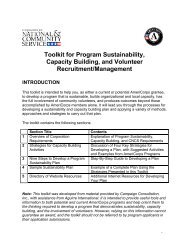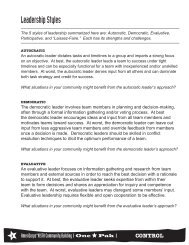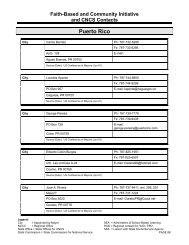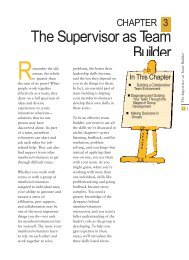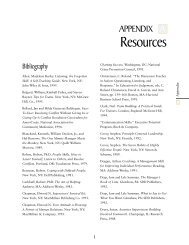MAKE IT LAST FOREVER: THE ... - National Service Resource Center
MAKE IT LAST FOREVER: THE ... - National Service Resource Center
MAKE IT LAST FOREVER: THE ... - National Service Resource Center
Create successful ePaper yourself
Turn your PDF publications into a flip-book with our unique Google optimized e-Paper software.
FUNCTION #3: LEADERSHIP<br />
inter-age and inter-school<br />
projects, community<br />
partnerships, and links to other<br />
educational initiatives.<br />
STRATEGY DESCRIPTION WHEN <strong>IT</strong>’S <strong>THE</strong>RE: WHEN <strong>IT</strong>’S NOT <strong>THE</strong>RE:<br />
State/District/Non-Profit<br />
Personnel:<br />
Coordinating staff at the<br />
departments of education,<br />
school districts and regions,<br />
and non-profit personnel,<br />
particularly those who are paid<br />
and full-time (or are VISTA<br />
members), provide invaluable<br />
assistance in training, technical<br />
assistance, logistical support,<br />
and promotion. Supportive<br />
activities by local or state<br />
school-boards and<br />
superintendents, particularly for<br />
Learn and Serve, make a major<br />
difference.<br />
Organizational Culture: When the use of servicelearning<br />
is so common in its<br />
use, this is usually because<br />
there is agreement among all<br />
within the system that servicelearning<br />
is valuable, as well as<br />
common ground regarding<br />
educational vision and goals.<br />
While some schools and<br />
districts seem to arrive at a<br />
consensus on this quite easily,<br />
others take a bit of persuading.<br />
The end result is that servicelearning<br />
is an expected, routine<br />
32<br />
People are available to provide<br />
help to those who need it, and<br />
these individuals can spend<br />
much time conducting outreach<br />
activities, training other<br />
educational personnel,<br />
developing intra-agency<br />
partnerships, and cultivating<br />
advisory boards to guide<br />
service-learning policy and<br />
practice.<br />
There is a profound sense of<br />
cohesiveness among faculty,<br />
between the principal and<br />
faculty, among students and<br />
faculty, and surrounding the<br />
entire school community.<br />
There is unquestioning belief in<br />
the value of service-learning,<br />
and a persistent commitment to<br />
its success.<br />
Teachers must rely on their<br />
own creativity and wit, which<br />
may only go so far when it<br />
comes to trying a new<br />
pedagogy. Part-time personnel,<br />
while helpful, may not be<br />
sufficient to catalyze adequate<br />
momentum to galvanize true<br />
support for service-learning.<br />
The lack of personnel reflects a<br />
lack of commitment by the<br />
institution(s) to servicelearning.<br />
<strong>Service</strong>-learning may be quite<br />
successful and practiced by<br />
some, many or even most<br />
faculty, but it lacks the sort of<br />
endorsement that contributes to<br />
complete support. In some<br />
cases, faculty can even obstruct<br />
this and other new methods<br />
with vigor or by other and more<br />
discreet forms of apathy. Most<br />
opposition is usually based on a<br />
failure to see the academic<br />
relevance of service-learning<br />
activities. This limits the



